
Stars, planets, universe and light years: Those are a few words that make the human imagination to spur, excite the human brain and challenge for the discovery of the endless universe and impel the human sight for the envisagement of the starry sky. This envisagement born the wish for understanding the way the stars were created, the way they move and how it could be possible for man to reach them.
The human desire to be close to the stars was the main idea for the conception of the ambiStar installation scenario. Through the use of interaction, an effort is made to allow the user to actively observe the starry night and to acoustically feel and interact with the stars. Motivated by the fact that, when we lay down and observe the starry night, almost always we stare at a star that seems to be unique for us, the installation scenario can be summarized as: move your star in space. The overall idea was enriched by evidences that focus on the way that the ancient Greeks (i.e. some students of Pythagoras), and later the well-known astronomer Kepler assigned sounds and melodies to the movements and orbits of the visible planets and stars.
Within the ambiStar installation environment, the user uses his hands aiming to alter the visual as well as the audio output of the system. More specifically, the position of his hand is mapped in real-time to the position of a star in the starry sky, thus offering a spatial interaction mechanism. Those spatial star position variations are combined with the equivalent alternation of the three dimensional (3D) soundfield, in an attempt for synthesizing the sound of the universe. This spatial soundscape representation is realized based on the concept that every celestial object produces a buzz in a different tonal pitch, according to its distance from the viewing point. The distances between the celestial objects are proportionally correlated with music intervals and in that way all celestial objects together produce a heavenly melody.
The interactive installation ambiStar was the result of the final year thesis (in greek only) of Mr. Nikolas Grigoriou. The installation was presented during the annual Festival organized by the Dept. of AudioVisual Department at Ionian University, on May 2009. Basic aim of this project was the combination of 3D sound representation techniques (such as ambisonics) that aim to realize realistic soundscapes and spatial interaction.
Gallery:
back
|
Andreas Floros Dr. Electrical & Computer Engineer |
|
Dept. of Audiovisual Arts Ionian University |
| Address Department of Audiovisual Arts Ionian University Plateia Eleftherias, Palaia Anaktora 49100 Corfu, Greece |
| Telephone | +30 26610 87725 |
| Fax | +30 26610 87866 |
| Skype | audioguy_gr |
| floros@ionio.gr |

